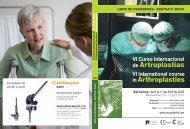cadera / hip - Active Congress.......
cadera / hip - Active Congress.......
cadera / hip - Active Congress.......
You also want an ePaper? Increase the reach of your titles
YUMPU automatically turns print PDFs into web optimized ePapers that Google loves.
JUEVES / THURSDAY<br />
234<br />
in extension after total knee arthroplasty fi rst<br />
should have release of the posterior oblique<br />
fi bers of the medial collateral ligament, and<br />
release of the posterior capsule if medial contracture<br />
persists in extension. This procedure<br />
leaves the anterior portion of the medial collateral<br />
ligament intact to stabilize the knee.<br />
Tight Medially in Flexion and Extension<br />
In many cases with a long-standing varus<br />
deformity and medial ligament contracture,<br />
the knee is tight medially both in fl exion and<br />
extension. This indicates that the entire MCL<br />
is contracted. The posterior capsule and PCL<br />
also may be contracted, but the primary contracture<br />
is the MCL in these cases. The PCL<br />
and posterior capsule cannot be evaluated<br />
until the MCL contracture has been corrected.<br />
Knees that are tight in fl exion and extension<br />
have release of the anterior and posterior portions<br />
of the medial collateral ligament. This is<br />
done by fi rst stripping the anterior portion of<br />
the medial collateral ligament in line with the<br />
tibial long axis, then directing the osteotome<br />
posteriorly to release the posterior portion of<br />
the ligament. Those knees that remain tight<br />
in full extension after release of the posterior<br />
oblique medial collateral ligament have<br />
release of the posterior medial capsule from<br />
the femur and tibia. If inappropriate posterior<br />
femoral rollback occurs, or if medial ligament<br />
tightness remains in fl exion after release of<br />
the anterior portion of the medial collateral<br />
ligament, the posterior cruciate ligament is<br />
released from its tibial attachment.<br />
Tight Popliteus Tendon<br />
Occasionally the popliteus tendon and its surrounding<br />
structures are tight in the varus knee<br />
after the medial side has been corrected.<br />
This often is diffi cult to detect, but rotational<br />
stability testing of the tibia demonstrates that<br />
the tibia is held anteriorly on the lateral side<br />
and pivots around the lateral edge of the tibial<br />
component. The popliteus tendon is released<br />
from its bone attachment when the knee is<br />
fl exed. It is found just distal and posterior<br />
to the lateral collateral ligament (LCL) at-<br />
tachment, and care must be taken to avoid<br />
release of the LCL during this procedure.<br />
Compensatory Lateral Release—Extension<br />
Only<br />
Occasionally, after full MCL release, the knee<br />
is excessively loose on the medial side in<br />
extension, and tight laterally. Compensatory<br />
lateral release corrects the imbalance, and a<br />
thicker tibial component brings the knee to<br />
correct stability.<br />
Compensatory Lateral Release—Flexion<br />
and Extension<br />
In some cases after full release of the MCL,<br />
the secondary stabilizers are inadequate to<br />
provide medial stability in fl exion and extension,<br />
and the knee is too loose medially after<br />
the tibial component has been sized to bring<br />
the lateral ligaments to their normal tension.<br />
In those cases the LCL and popliteus tendon<br />
are released to create more laxity both in<br />
fl exion and extension, and a thicker tibial<br />
component is used to tension the medial<br />
structures.<br />
THE IMPACT OF<br />
LIGAMENT BALANCING IN<br />
TOTAL KNEE ARTHROPLASTY<br />
J. Romero, M.D.<br />
Endoclinic Zurich, Center for Arthroplasty<br />
and Joint Surgery,<br />
Klinik Hirslanden, Switzerland<br />
Symmetrically balanced collateral soft tissues<br />
in extension and in fl exion 1, 2 and alignment of<br />
the tibial and femoral components perpendicular<br />
to the mechanical axis in the coronal plane 3 are<br />
major surgical goals in total knee arthroplasty.<br />
Erroneous resection of the tibial plateau and<br />
distal femoral condyles or inadequate soft tissue<br />
release for varus or valgus contracture will result<br />
in an asymmetric extension gap. Extension gap<br />
imbalance due to insuffi cient soft tissue release<br />
may cause polyethylene edge overload 4 and





